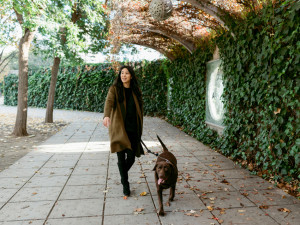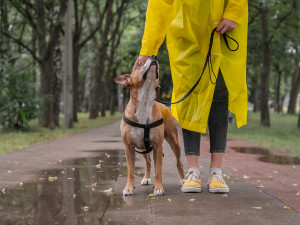“Why Won’t My Dog Walk Outside?”
Dog behaviorist Karen B. London’s 7 tips to help get your parked pet moving.

Share Article
Why doesn’t my puppy like walks? He loves to play inside the house, but he doesn’t enjoy going on walks around the neighborhood. I often wind up picking him up and carrying him, but even that freaks him out. He seems more inclined to walk when the rest of the family is around, but not when it’s just the two of us. What can I do?
Don’t stress — it’s not at all unusual for puppies to resist going on walks! The good news is most dogs get more enthusiastic about them as they get older. In the meantime, here are some things you can do to get your puppy moving:
Use a puppy-size collar and leash.
Sometimes, a dog’s resistance to walks relates to equipment. Many puppies freeze up a little when they wear a leash and collar because they’re not used to them. To help alleviate this roadblock, make sure that any collar or harness you’re using fits well and is the right size. Puppy-size pups need puppy-size leashes and collars; for very small puppies, a cat leash may be the best option. Help them get accustomed to the walking gear by putting it on them inside the house. Then, play or do a little bit of training with them while they’re suited up.
If your puppy tries to wiggle free or back out of their collar or harness, definitely use a martingale collar. Also called no-slip or limited-slip collars, martingale collars are far safer and provide more control than typical flat collars. They look a lot like a flat collar, but have an extra loop of fabric with a D-ring attached which causes the collar to gently tighten when a pup pulls in the opposite direction — preventing escape.

Start with short, slow walks.
Make the walk manageable by setting reasonable expectations. Encourage your pup to go a short distance (even a few houses down the block), then return. Don’t push the pace — let your pup amble as slowly as they like. Many puppies’ walking skills improve with short, positive experiences; walks that are too long or too fast can overwhelm them.
Walk your pup somewhere familiar.
Some dogs find walks intimidating because everything is new. One way to get them used to walking near your home is to drive the two of you a few houses away and then encourage them to walk home with you. Many dogs, especially puppies, are more enthusiastic walkers when the route is taking them to a familiar place instead of away from that familiar place. (Don’t try this if your dog dislikes riding in the car.)
Plant a hidden treasure.
Another way to help your pup become more excited about walking is to hide a toy or stuffed Kong along the route so they have the wonderful experience of finding a treasure. Do this periodically, varying the location, direction, and distance so you don’t end up with a dog who’s only interested in going one way.
Make it a group activity.
If your puppy is more enthusiastic when other people are around, they must be pretty social. Maybe they don’t like to leave anyone behind, or they’re just more playful in a larger group. Try walking your pup with another person and another puppy to see if that makes them more eager to get moving. If it does, that may translate to greater willingness to walk when it’s just the two of you.
Use the “stay” command.
Ask your pup to stay, then release with “Okay!” and see if they bound forward. Many dogs are very enthusiastic to move at the end of a stay. If this works with your pup, you can use the technique a couple of times on a walk (but not too often, or it may stop being effective).
Practice patience.
The most important thing I can recommend is that you be patient with your pup. Short, pressure-free walks may not be satisfying for you, but they will go a long way toward making your pup a more willing walker. On the flip side, pushing your pup too far, too fast may make them fearful — which is definitely not the goal.

Karen B. London, PhD, CAAB, CPDT-KA
Karen B. London is a certified applied animal behaviorist (CAAB) and certified professional dog trainer (CPDT) who specializes in working with dogs with serious behavioral issues, including aggression. She has written for a variety of magazines including The Bark, Clean Run, and the APDT Chronicle of the Dog, and has published in scientific journals including Behavioral Ecology and Sociobiology, Ethology, Ecology, and Evolution, the Journal of Insect Behavior, and Insectes Sociaux. She is the author of seven books about dog training and canine behavior, including the forthcoming My Dog's Mystery Adventure: And Other Stories From a Canine Behaviorist and Dog Trainer.
Related articles
![Dog playing the shell game with her human. Concept of training pets, domestic dogs being smart and educated]()
4 Ways to Keep Your Dog Busy When They Can’t Exercise
Even if your dog is injured and can't exercise, you can still keep them entertained. Here's how.
How to Manage Leash Reactivity in Your Dog
If your pup acts diabolical on walks, you are not alone. Here’s what you can do.
![Woman walking her dog in a park]()
Dog Walking 101: How Often Should You Walk Your Dog?
And why you shouldn’t skip the longer routes.
![Pet parent walking Staffordshire terrier dog on a leash in urban park in the rain]()
The 3 Types of Dogs on Walks
Which one is yours?





